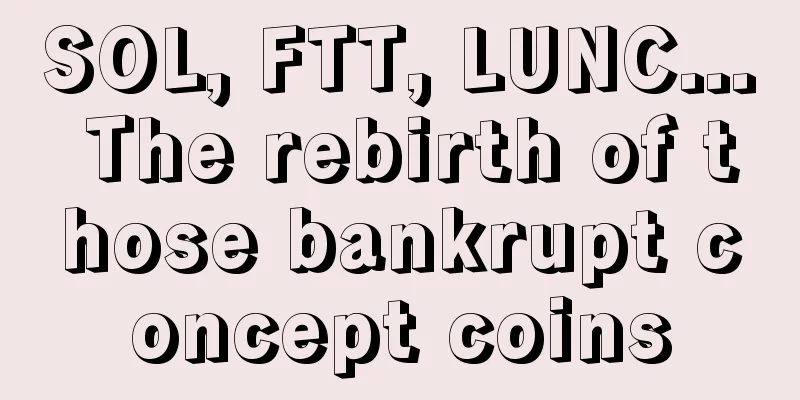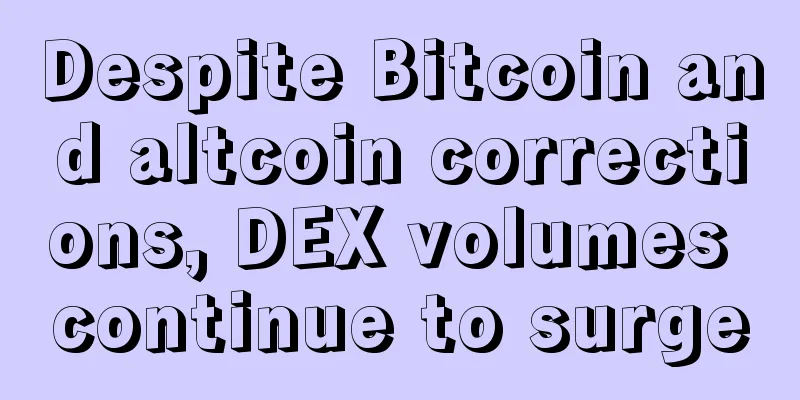SOL, FTT, LUNC... The rebirth of those bankrupt concept coins

|
The crypto industry is not only full of crashes, speculation, and scams, but also has inspiring stories of well-known projects that fell and then stood up again. SOL, FTT, LUNA, LUNC, RAY, VGX, etc., these are all currencies that have plummeted due to the exposure and collapse of leading institutions in the crypto industry such as FTX, Terra, and Voyager Digital. But few people could have imagined that in just one year, these bankrupt concept coins could be on the road to revival. At the end of the year, Golden Finance will take you to see how those bankrupt concept coins in 2023 reverse the gears of fate in the bear market. 1. Return to the topSOL, FTT, LUNC, with the end of the court cases, each project has entered a reconstruction period, and the inherent project background has allowed them to be recognized by the market again. The crypto market has been on a downward trend since it peaked in November 2021, but the price of Solana's ecosystem token SOL has already fallen from around $260 to $30. However, due to the FTX crash in November 2022, SOL plummeted again, falling to as low as $8. Just when most investors were still wondering whether this was the bottom of SOL, SOL was reborn in 2023. The price has been rising all the way to $126, an increase of 1475%. Similarly, due to the FTX bankruptcy incident, its platform currency FTT fell. After being around US$20, it fell to a low of around US$1. However, with the end of the SBF trial and the call for FTX to restart, the price of FTT has risen. The price of the coin has risen to $6 so far this year, an increase of 600%. Terra Classic (LUNC) is an algorithmic stablecoin platform that runs on a Proof of Stake (PoS) blockchain infrastructure built by Tendermint. It is home to the algorithmic stablecoin terraclassicusd (USTC). After the USTC decoupling in May 2022, the community behind Terra Classic decided to create a new blockchain without an algorithmic stablecoin, called Terra 2.0. New LUNA tokens were airdropped to old users affected by the Terra exposure incident. The historical lowest point of LUNC after its issuance was around US$0.000054. This year it rose to a high of US$0.00028, an increase of 418%. LUNA, RAY, and VGX have also seen varying degrees of recovery this year, at 255%, 1321%, and 65%, respectively. 2. The Lost RoadLooking back at these bankrupt concept projects, most of them fell to the bottom due to problems exposed due to the bearish trend of the cryptocurrency market. In November 2022, CoinDesk disclosed documents indicating that FTX and its sister company Alameda Research may have debt problems. This news triggered a crisis of trust among users, which eventually led to a run on FTX funds and a break in cash flow. FTX went bankrupt in just a few days. The document pointed out that most of Alameda's balance sheet assets are FTT, the token issued by the FTX platform. The largest single asset is FTT worth US$3.66 billion, as well as public chain tokens SOL and Solana ecosystem Token worth US$3.37 billion, in addition to loans of up to US$7.4 billion. In addition, most of Alameda’s assets are closely related to FTX and Solana tokens, which not only have poor market liquidity and high volatility risk in valuation, but the company’s liabilities are real US dollar liabilities. Combined with the fact that some researchers have previously found that FTX’s reserves are constantly being lost, this has begun to cause some cryptocurrency investors to worry about the FTX exchange. After the FTX crash, Zhu Su, co-founder of Three Arrows Capital, said in an interview in Abu Dhabi: “Some industry leaders said that the FTX crash set the industry back five years, but I think it’s more serious, about seven to eight years. If the fundamental problems are not properly resolved, the setback will be even longer.” The collapse of FTX exposed the high risks of the crypto industry. U.S. Treasury Secretary Janet Yellen said that the U.S. government has considered regulating the industry in accordance with President Biden’s executive order. Judging from the reactions of all parties at the time, the mainstream view on the prospects of FTX-related currencies was not optimistic. Another major exposure event in 2022 was the collapse of the Terra Empire, which also created a record of plummeting mainstream star currencies on crypto exchanges. Terra had already encountered a crisis in 2021. Starting in late May of that year, the crypto market fell like a waterfall. On the 19th of that month, Bitcoin fell by 30%, and the overall market sentiment also began to fall. Luna was no exception, with the price falling to $4.10, a 75% drop from the previous week's trading price. Seeing this, investors began to lose confidence in Luna and reduced demand for UST. This directly caused the price of UST to fall below its peg of $1, and prompted more and more holders to exchange their UST for Luna. However, this run by holders will cause Luna over-issuance, currency inflation, and further decline in token prices, exacerbating a vicious cycle. Many people are worried about a total collapse, which will trigger a "death spiral." But the Terra ecosystem withstood the pressure and survived with its previous capital reserves. However, on May 8 of the following year, Terra moved $150 million of UST to adjust liquidity, but 10 minutes later a new address suddenly sold $84 million of UST, which immediately triggered a wave of selling and panic. On that day, the price of UST continued to stagnate at the 95 cent level, which further stimulated the selling wave. As the price of Bitcoin continued to fall, Terra's capital reserves shrank, and Do Kwon was unable to raise enough Bitcoin funds to buy back enough UST. Just as the event in May 2021 repeated itself, a death spiral occurred and investors ran a bank run. After that, the whole situation quickly got out of control, UST accelerated its decoupling from the US dollar, collapsed completely on the 9th, and depreciated by 99% in 48 hours. On May 17, the price of LUNA coin almost dropped to zero, and a business empire valued at $40 billion collapsed overnight. The collapse of the above two institutions caused turmoil in the crypto market. Many related concept currencies were implicated and continued to fall. Investors are generally no longer optimistic about such concept currencies. At the end of December 2022, SOL fell to the bottom, only $8. Just when the outside world unanimously believed that the former "Ethereum killer" was about to collapse, Ethereum founder Vitalik Buterin tweeted, "Some smart people told me that Solana is a serious and smart development community, and now those terrible opportunists have been washed away, and the Solana chain will have a bright future. It's hard for me to judge from the outside whether this is the case, but I hope the community has a fair chance to thrive." 3. Hope Rekindled Keep working and struggling to survive in the long bear market. On November 3 this year, FTX founder Sam Bankman-Fried was found guilty. After a month of trial, a 12-member jury in the Manhattan Federal Court found all seven charges against SBF guilty. Regardless of whether SBF can successfully appeal, it has already been explained to FTX and the outside world. As the SBF court case came to an end, several well-known financial institutions expressed their willingness to participate in the FTX restart plan. SEC Chairman Gary Gensler said that anyone who wants to restart FTX can do so within the law. As for the currencies associated with the Terra ecosystem, since November this year, the Montenegrin court approved the extradition of cryptocurrency tycoon Do Kwon (founder of Terra) to South Korea or the United States, and the Montenegrin Minister of Justice will make an extradition decision. The market began to believe that this indicates that the case will enter the final stage. And on December 1, media reported that the class action lawsuit against Terraform Labs and its co-founder Do Kwon was continuing, and the defendant's appeal was dismissed by the Singapore High Court. These news directly or indirectly stimulated the rise in the prices of tokens such as LUNA and LUNC. If the case can make further progress in the future, the price of the token may continue to rise. For VGX, which has similar experiences with the above two institutions, the recent price increase is not very large, but it is still satisfactory for a bankruptcy concept coin. The biggest factor behind its rise is that Voyager Digital, the crypto lender behind VGX, reached a settlement with the U.S. Federal Trade Commission (FTC) in October, permanently banning it from handling consumer assets and filing a lawsuit against its former CEO Stephen Ehrlich, accusing him of lying about customer accounts being insured by the Federal Deposit Insurance Corporation. Among all the bankruptcy concept sectors, the most anticipated and surprising one is the resurgence of Solana and its ecosystem. As of writing, its TVL has exceeded 1.4 billion US dollars. Its ecosystem DEX protocol Raydium token RAY has also benefited from this, with an astonishing increase. In addition, data shows that in the last month of this year, the number of active addresses and the number of new addresses on the Solana network have set their highest records of the year. In addition to the end of the SBF case, this is inseparable from the continuous efforts of the project team. From the perspective of time, the biggest driving force behind Solana's takeoff is likely OKX. On October 11, the price of SOL was about $22, and the low point in the previous few months was $17. However, since the OKX Web3 wallet and Solana Ecosystem jointly announced an in-depth cooperation that day, SOL has entered a soaring mode. Then on November 2, the two parties started the second round of activities. Just one week later, the price of SOL took off again. Solana officially announced that its ecosystem will launch the OKX Web3 application on the app store of its Web3 smartphone Saga, and provide multi-level support such as brand and market. In addition, the two parties will jointly explore opportunities for cooperation between Solana Pay and traditional Web2 head brands and provide support for resource integration to further strengthen the connection between the two ecosystems. Through this cooperation, the OKX Web3 wallet and Solana ecosystem will increase the global connectivity of the Web3 field, promote global resource docking and innovation, and empower global users, jointly creating a path towards a more decentralized and interconnected Web3 future and providing users with more possibilities. In addition, the Solana Foundation is actively promoting the project. The Solana Ecosystem Meetup was held on December 14 in Taipei, Taiwan, China, the BreakPoint Conference, the Hong Kong Hacker House, and more. Many institutions have expressed their views on Solana. Cathie Wood, CEO of ARK Invest, said in an interview with CNBC that Ethereum has faster transaction speeds and lower transaction costs than Bitcoin. Solana is faster and more cost-effective than Ethereum. Asset management company VanEck released a report saying that if Solana can gain dominance in the crypto market, SOL may rise to $3,211 in a bull market in 2030. Speaking of technology, Solana Foundation Strategy Director Austin Federa explained in a podcast how Solana builders persevered during the deep bear market and continued to improve the project's technology. According to him, Solana's recent performance improvements have corrected many of the problems that plagued its performance during the 2021 bull market. In addition, the Solana EVM-compatible Neon testnet already allows users to pay transaction fees with tokens such as SOL, USDC, and USDT instead of the platform’s native tokens. This feature is planned to be launched on the Neon EVM development network in the coming weeks, and mainnet support is expected to be provided in Q1 2024. Additionally, Solana nodes can now be quickly deployed on AWS using the infrastructure-as-code application in the AWS Blockchain Node Runners repository. Conclusion The crypto industry is seen as a dark forest, full of dangers, but also full of unknown opportunities. The collapse of one crypto institution after another has exposed the risks in the crypto market, and the resilience of crypto companies has been proven by their rebirth when they are generally looked down upon by the outside world. Similarly, for start-ups, the market and investors should be more tolerant and less biased. Looking back, it has only been 15 years since the birth of the Bitcoin white paper, and Ethereum has also been sold at a low price, so we might as well focus more on the value of the project itself. |
<<: Preparing for 2024: What plans have the leading players in the crypto industry made?
>>: Classic tactics reappear: How did the demon currency TRB achieve bloodbath in the market?
Recommend
Localethereum: Talking about currency security from the hack of the world's seventh largest digital currency exchange
According to Yonhap News Agency, Bithumb, the wor...
What kind of face indicates a man with good fortune?
A person's destiny is actually reflected in h...
Dell 550W Power Supply Review
Power supply model: DELL-AA23300 Brand: Dell Spar...
Four moles on a woman's neck - illustration and analysis of moles
If you observe carefully, you can find that every...
What do the nasolabial lines at the corners of the mouth mean?
I believe everyone knows nasolabial folds, which ...
Women with moles on their backs are destined to marry far away
Is it good for a woman to have a mole on her back...
Knowing People’s Hearts by Their Faces (Part 2)
Physiognomy is one of the five arts in Chinese cu...
When it comes to digital currency entrepreneurship, passion is more important than money
The main reason I wrote this article is to share ...
What are the celebrities with broken palms?
A broken palm is a special line on our palm. Amon...
Chengdu is expected to become a new highland for the development of blockchain in my country
Chengdu is also known as the "Land of Abunda...
Women with protruding lips are scheming.
Have you ever found in your daily life that some ...
Ethereum EIP-1559 upgrade is imminent, but derivative indicators show that traders are not optimistic
Derivatives data shows that traders are not as bu...
Face fortune telling: What kind of man cares most about face
Click to enter more calculations The most face-co...
How can a man with a big mouth live a life without worries about food and clothing?
As the saying goes: A man with a big mouth eats a...
Where is the correct location of the mole of misery? What does the mole of misery represent?
Moles are rooted on people's faces or bodies ...









